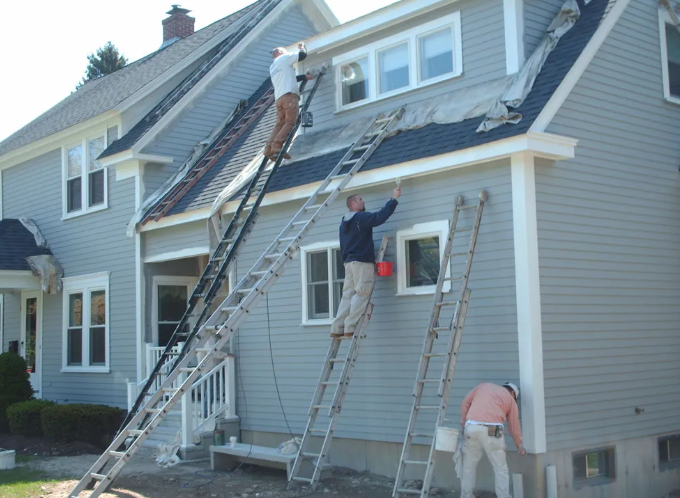Homeowners often invest significant time and money into exterior paint projects, only to see the results deteriorate faster than expected. Many professionals, including exterior painters in marietta, emphasize that climate and seasonal weather patterns play a major role in determining how long exterior paint will last. Understanding how temperature, moisture, sunlight, and seasonal changes affect exterior surfaces can help homeowners make better decisions when planning a paint job and maintaining their home’s appearance.
Understanding the Role of Temperature
Temperature is one of the most influential factors affecting exterior paint longevity. Paint requires specific temperature ranges to cure properly. When applied in extreme heat, paint can dry too quickly, causing it to form weak bonds with the surface. This often leads to cracking, peeling, and premature fading.
Cold temperatures create additional challenges. Paint applied in low temperatures may not dry fully, allowing moisture to become trapped beneath the surface. This can result in bubbling, blistering, or mold growth. Ideal painting conditions generally fall between 50°F and 85°F, although specific products may differ. Choosing the right season for painting and monitoring temperature fluctuations are essential steps in protecting paint performance.
The Impact of Humidity and Moisture
Moisture levels significantly influence the durability of exterior paint. High humidity slows drying time, making paint more susceptible to dirt and debris sticking to it before it cures. Excess moisture can also seep into wood or siding, pushing paint outward and causing it to peel.
Rain presents an obvious threat, but morning dew and humidity spikes can be just as damaging. In areas where humidity is consistently high, mold and mildew growth on painted surfaces become common concerns. Selecting moisture-resistant paints and ensuring proper surface preparation can greatly reduce these risks.
Sun Exposure and UV Damage
Sunlight, especially ultraviolet radiation, is one of the leading causes of paint fading and breakdown. UV rays gradually weaken the chemical structure of paint, causing colors to lose vibrancy and the surface to become chalky. South-facing walls often show the most damage due to prolonged direct exposure.
High-quality exterior paints include UV-resistant additives that help slow this process. Lighter colors generally withstand sunlight better than darker tones, which absorb more heat and fade more quickly. Homeowners living in sunny climates should prioritize UV protection when selecting paint products.
Seasonal Weather Variations
Each season presents unique challenges that affect exterior paint longevity.
Spring
Spring moisture can interfere with painting projects. Frequent rain and fluctuating temperatures make it difficult for paint to dry correctly. However, late spring often provides ideal conditions once temperatures stabilize.
Summer
Summer heat speeds up drying time, sometimes too quickly. Heatwaves and strong sunlight can cause paint to crack or bubble. Painters often work early in the morning or late in the afternoon during summer to avoid peak heat.
Fall
Fall is widely considered one of the best seasons for exterior painting. Temperatures are moderate, humidity levels drop, and weather patterns stabilize. However, early freezes or sudden temperature drops can still cause problems.
Winter
Winter creates the harshest environment for paint. Freezing temperatures slow curing and allow moisture intrusion. In cold regions, painting during winter is rarely recommended unless specialized cold-weather paints are used.
Wind and Environmental Pollutants
Wind contributes to paint deterioration in several ways. Strong winds may carry dust, sand, or debris that can erode painted surfaces over time. Wind also complicates the painting process by drying paint unevenly or blowing contaminants onto wet surfaces.
Pollution and salt exposure can accelerate wear as well. Homes near busy roads, industrial zones, or coastal environments often require more frequent repainting due to chemical reactions and salt corrosion.
Surface Preparation and Material Differences
Climate and weather effects vary depending on the type of exterior material being painted. Wood expands and contracts with temperature and moisture changes, making it more prone to peeling. Brick and stucco absorb moisture differently, requiring breathable paint formulations to prevent trapping water.
Proper surface preparation plays a major role in paint longevity. Cleaning, sanding, repairing damage, and applying primer create a strong foundation that withstands climate-related stress.
Choosing the Right Paint and Timing
To maximize exterior paint durability, homeowners should:
• Use high-quality exterior paints designed for their regional climate
• Avoid painting immediately before or after rain
• Choose breathable, moisture-resistant coatings
• Schedule painting during stable weather periods
• Consider UV-resistant and mildew-resistant products
Professional painters often track weather forecasts and plan projects carefully to ensure optimal drying and curing conditions.
Maintenance for Long-Term Protection
Even the best paint job requires ongoing maintenance. Regular inspections allow homeowners to identify early signs of wear, such as fading, cracking, or mildew growth. Cleaning painted surfaces yearly helps remove dirt, pollution, and biological growth that can damage paint over time.
Touch-ups and sealing exposed areas can extend the lifespan of exterior paint significantly. Proper gutter maintenance and landscaping control can also prevent moisture-related damage.
Conclusion
Climate and seasonal weather conditions play a powerful role in determining how long exterior paint will last. By understanding how temperature, humidity, sunlight, and seasonal changes affect paint performance, homeowners can better plan their painting projects and protect their home’s exterior. Choosing the right paints, applying them in favorable conditions, and maintaining surfaces regularly will help ensure a long-lasting and visually appealing finish.

